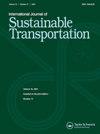What drives university students to cycle? An investigation of their motivations
IF 3.1
3区 工程技术
Q2 ENVIRONMENTAL STUDIES
International Journal of Sustainable Transportation
Pub Date : 2025-03-04
DOI:10.1080/15568318.2025.2455010
引用次数: 0
Abstract
The objective of this study is to identify the factors that influence the increase in the number of students cycling to university. An online questionnaire was administered to 2,130 students at the University of Trieste (Italy) to assess their stated preferences for cycling in the presence of various infrastructure and facilities, including cycle lanes, green infrastructure, secure parking, and e-bike charging stations. The findings indicate that students are responsive to the financial aspects of cycling, suggesting that subsidies for the purchase of bicycles or bike-share services could increase cycling rates. However, the study also highlights that infrastructure factors—such as the availability of dedicated cycle lanes, secure bicycle parking, and e-bike charging points on campus—are equally, if not more, important in determining the likelihood of students cycling to university. Additionally, linear green infrastructure, such as roads with greenery along the edges (e.g. grass verges, trees, or bushes), was found to be the second most important type of infrastructure for encouraging students residing in the urban area to cycle. Latent psychological factors, such as perceptions of urban safety for cycling and anticipated health and fatigue effects, were also significant in influencing the decision to cycle. Our findings will be useful to policy makers, local authorities and university mobility managers in the design, planning and implementation of policies that can effectively increase the uptake of cycling for commuting to university.
是什么促使大学生骑自行车?调查他们的动机
本研究的目的是找出影响骑自行车上大学的学生人数增加的因素。意大利的里雅斯特大学(University of Trieste)对2130名学生进行了一份在线问卷调查,以评估他们在各种基础设施和设施(包括自行车道、绿色基础设施、安全停车场和电动自行车充电站)存在的情况下对骑自行车的偏好。调查结果表明,学生对自行车的经济方面有反应,这表明购买自行车或共享单车服务的补贴可能会增加骑自行车的比例。然而,该研究还强调,基础设施因素,如专用自行车道的可用性、安全的自行车停放和校园内的电动自行车充电点,在决定学生骑自行车上大学的可能性方面同样重要,如果不是更重要的话。此外,线性绿色基础设施,如沿着边缘(如草地边缘、树木或灌木丛)的绿色道路,被发现是鼓励居住在城市地区的学生骑自行车的第二重要的基础设施类型。潜在的心理因素,如对城市骑自行车安全的看法以及预期的健康和疲劳影响,在影响骑自行车的决定方面也很重要。我们的研究结果将对政策制定者、地方当局和大学交通管理人员在设计、规划和实施政策方面有所帮助,这些政策可以有效地增加骑车上学的人数。
本文章由计算机程序翻译,如有差异,请以英文原文为准。
求助全文
约1分钟内获得全文
求助全文
来源期刊
CiteScore
8.90
自引率
2.60%
发文量
56
期刊介绍:
The International Journal of Sustainable Transportation provides a discussion forum for the exchange of new and innovative ideas on sustainable transportation research in the context of environmental, economical, social, and engineering aspects, as well as current and future interactions of transportation systems and other urban subsystems. The scope includes the examination of overall sustainability of any transportation system, including its infrastructure, vehicle, operation, and maintenance; the integration of social science disciplines, engineering, and information technology with transportation; the understanding of the comparative aspects of different transportation systems from a global perspective; qualitative and quantitative transportation studies; and case studies, surveys, and expository papers in an international or local context. Equal emphasis is placed on the problems of sustainable transportation that are associated with passenger and freight transportation modes in both industrialized and non-industrialized areas. All submitted manuscripts are subject to initial evaluation by the Editors and, if found suitable for further consideration, to peer review by independent, anonymous expert reviewers. All peer review is single-blind. Submissions are made online via ScholarOne Manuscripts.

 求助内容:
求助内容: 应助结果提醒方式:
应助结果提醒方式:


